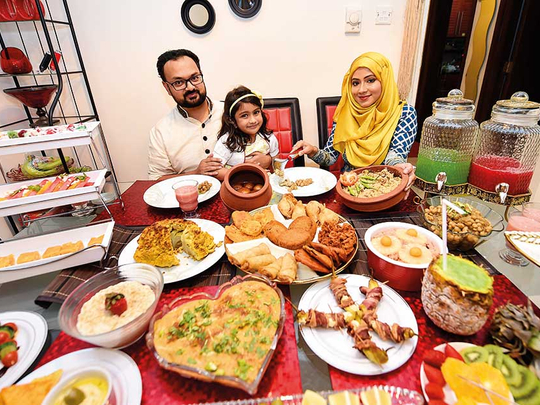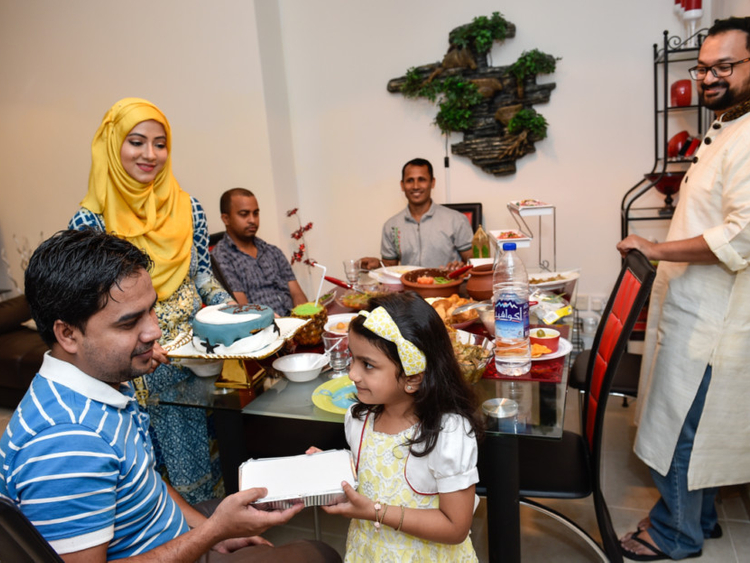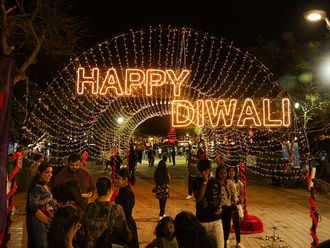
Abu Dhabi: For Jehan Jafar and Musabbir Hussain, iftar is always reminiscent of their childhood in Abu Dhabi.
The Dubai-based couple, who grew up in the capital city, fondly remember warm Ramadan meals with their respective families, followed by nightly prayers at the local mosque.
The dishes in the iftar meals have changed slightly over the years, and there is another element to them as well: a concerted effort to share their blessings with people around them.
As iftar approaches, Jehan, a 30-year-old homemaker, packs a range of dishes into parcels, ready to be shared with workers and other friends in the neighbourhood. Her husband, Hussain, and their five-year-old daughter, Inaaya, diligently distribute the food before the evening call to prayer.
Back at home, Jehan has set out an expansive iftar.
“I remember how my mother loved cooking for us, and I try to replicate that special Ramadan feeling in our home now,” she told Gulf News.
Taking pride of place was a clay pot of beef tehari, an authentic Bangladeshi rice and meat-based dish with a delicious aroma of mustard oil.
“It’s very much like a biryani, but the aroma is even more striking. Today, I’ve made beef tehari, although it can also be prepared with chicken or mutton,” Jehan explained.
“We love having traditional food like this for iftar, including the potato, chilli and lentil fritters which are part of every Bangladeshi iftar,” she adds, indicating a platter of crispy golden fritters nearby. Another traditional favourite taking its rightful place on the table was haleem, a spicy meat, lentil and wheat stew that is usually garnished with coriander, chilli, lemon juice and chopped garlic. And a Bangladeshi iftar meal is never complete without the customary bowl of chickpeas.
She also enjoys making ‘fusion cuisine’. “For example, my husband loves cauliflower roast, which I stuff with minced meat,” she says.
There are also stuffed jalapeno wraps, a platter of nachos with hummus dip, some oatmeal and strawberries, and two colourful fruit platters.
“We usually have some rose milk for iftar, and today I’ve made some pineapple sherbet too, which my daughter loves,” Jehan says.
To give this sumptuous spread the sweet finish, there is dessert including some brick-red laal mohan, a Bangladeshi gulab jamun (fried balls of milk-based dough dipped in syrup), some zarda, an orange-coloured sweet rice dish garnished with pineapple, and a rainbow Jello cake.
“As you can tell, my wife’s food is always very good and I love it that she gives even the most routine dish a special twist,” says Hussain. “She is also very careful about our health in Ramadan, so instead of frying the fritters, she bakes them,” he adds.
“Every Ramadan, he also buys me a new kitchen appliance. Last year, he bought me an air fryer, and this time, he bought a food processor that I cannot wait to use.”
The couple say they make an extra effort to make Ramadan and Eid special for their daughter.
“We want her to enjoy the various aspects of her faith. So before Ramadan, we decorate the house with streamers and balloons, and I bake her a ‘Ramadan Kareem’ cake, just as I’ve done again today,” says Jehan.
Inaaya cannot yet fast as she is too young, but her mother says she loves being part of the various Ramadan traditions.
“She tries to help with the cooking, like mashing potatoes for the chickpea dish, for instance, and assists me in setting the iftar table. But she doesn’t yet understand what it means to fast from dawn to dusk. This year, she says she wants to fast and I tell her she can fast multiple times until it is time for her to eat,” she said.
Even though the family now lives in Dubai, Hussain recalls his childhood, especially the special sense of warmth that Ramadan brought to the capital.
“I would end the fast with my parents and brother at home, and those iftar meals always included dates, some fruit, chickpeas, fried fritters, and the delicious sweet rice cakes my mother loved to make. Afterwards, about 15 to 20 of my friends would gather every day, and we would all attend the Taraweeh prayers at the mosque,” he said.
One could not miss the spirit of sharing that was such a vital part of Ramadan in the early 1990s, Jafar says.
“Just before iftar, someone would always ring your doorbell and there would be more dishes brought in by the neighbours. Otherwise, we would pack some of my mother’s food, and take it over to a friend’s house,” Jafar said.
The family is now setting their own Ramadan custom of caring and sharing.
BOX
Recipe: Beef tehari
Tehari is an authentic Bangladeshi aromatic rice dish that packs a pleasant punch thanks to the green chillies and curried beef. It is popular in old Dhaka. The dish can be prepared with meat or chicken.
Ingredients
For tehari masala:
10 pieces cardamom
2 cinnamon sticks (1.5 inches each)
1/2 piece nutmeg
3 pieces mace (small)
For beef curry:
1.5kg beef (cut into small pieces)
300ml oil
3 tbsp mustard oil
1 cup friend onions
3 tbsp ginger paste
2 tbsp garlic paste
1 tbsp tehari masala
1 cup water
5 green chillies (slit)
3 tbsp of yoghurt
Salt (to taste)
1 cup water
For tehari:
1kg rice
1.5 litres hot water
Salt (to taste)
3 tbsp of milk powder (mixed in 1/2 cup of hot water)
10 to 12 raisins
10 green chilies
1 tbsp of kewra water (vetiver essence)
Caramelised onions and green chillies to garnish
Method:
Make the tehari masala by grinding all the ingredients into a fine powder.
For the beef curry, heat oil in a deep saucepan on medium high heat. Add sliced onions and saute until golden brown, then add the ginger and garlic pastes and the tehari masala. Pour in the water and keep stirring, while adding the green chillies and salt. After about a minute, add the beef and yoghurt, then cover and let the curry simmer on a low flame. Stir the curry occasionally. When the oil separates from the beef and the pieces are tender, remove the saucepan from the flame. Strain the curry and reserve the oil.
For the final step, heat the reserved oil in a large pan. Add the rice to the oil and fry lightly. Then add the hot water, salt to taste, and hot milk mix and stir. Add the raisins and green chilies, along with kewra water. When the rice is almost cooked, add the beef curry to it and let it cook for around 20 minutes. Stir gently from time to time and add some ghee. When the rice is cooked, top with caramelised onions and green chillies. Serve immediately.











